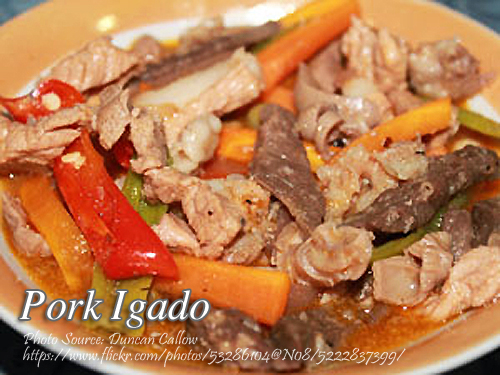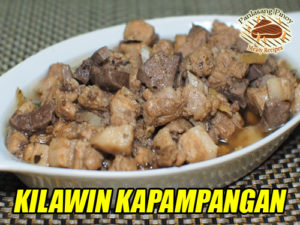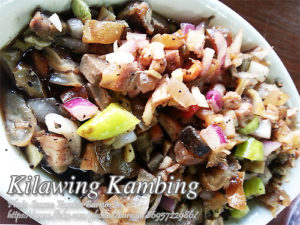Igado is one of the popular Ilokano dish that consists of pork meat and pork innards like liver, heart and kidneys. In my opinion it is similar to preparing a kilawin or ceviche dish which is usually done in fish. But since the pork is not safe to be eaten raw because of the parasites still on the meat, it has to be well cooked. Before cooking pork igado, you have to marinate the pork and innards in vinegar. Aside from pork igado, there are also other variation like the beef igado and chicken igado.
Pork Igado: A Hearty Ilokano Classic with a Story to Tell
There’s something about the smell of garlic sizzling in oil that instantly takes me back to childhood afternoons in my grandmother’s kitchen in Ilocos Norte. A dish as hearty as the love poured into every pot, was a staple in our home. My uncle Lando, who worked as a farmer, swore by this recipe as the perfect comfort food after a long day in the fields.
Growing up, this dish was more than just a meal; it was a symbol of family gatherings, stories shared over dinner, and the rich culinary heritage of the Ilokano people. While its name might not be as famous as adobo or sinigang, it has an enduring charm that’s well worth exploring.
What Makes Pork Igado Special?
Pork Igado is a classic Ilokano dish made from pork meat and innards like liver, heart, and kidneys. If you’re unfamiliar with using innards, don’t let that intimidate you. These ingredients give the dish its signature depth of flavor and make it a true representation of resourcefulness in Filipino cooking.
My aunt Elena used to tell us that the origins of igado can be traced back to the Spanish colonization of the Philippines. The word “igado” comes from the Spanish higado, meaning liver, which is one of the key ingredients in the dish. Much like other Filipino recipes influenced by the Spanish, this dish emphasizes bold flavors and a balance of savory and tangy elements.
Preparing the Ingredients: The Secret to Success
My cousin Armando, a self-proclaimed kitchen expert, always says that the secret to a great pork igado starts with marinating the liver and innards in vinegar. This step isn’t just about adding flavor; it also helps reduce the gaminess of the offal and tenderizes the meat.
Vinegar plays a crucial role in many Filipino dishes, and it adds that signature tang that cuts through the richness of the pork. The acidity balances the overall flavor, making every bite deeply satisfying.
Once the marinating is done, it’s time to sauté garlic in oil until it turns a beautiful reddish-brown. This step enhances the garlic’s natural sweetness and infuses the oil with flavor, which serves as the base for the dish. It’s a small detail, but one that elevates the overall taste.
Cooking the Perfect Pork Igado
When the garlic is ready, the marinated innards—liver, heart, and kidney—are added to the pan. My lola always reminded us to stir constantly at this stage. Stirring ensures the ingredients are evenly cooked and prevents the liver from becoming tough.
Once the innards are well-coated and partially cooked, soy sauce is added. The salty, umami-rich soy sauce complements the tanginess of the vinegar, creating a flavor profile that’s uniquely Filipino. Simmering the mixture allows the flavors to meld together while tenderizing the meat further.
As the sauce thickens, green peas and chili peppers are added for a burst of color and a hint of spice. My sister Mia, who’s not a fan of too much heat, always adds just a few chili peppers. But if you’re like my uncle Lando, who enjoyed his igado with a fiery kick, you can add more to suit your taste.
A Dish Steeped in Tradition
Pork Igado isn’t just a dish; it’s a testament to the ingenuity of Ilokano cuisine. Like many regional dishes in the Philippines, it reflects a “waste-not” approach to cooking, utilizing every part of the animal to create something delicious and nourishing.
This dish also speaks to the Filipino tradition of gathering and sharing meals. In my family, it was a must-have during fiestas and reunions. My father would always say that a meal made with love—and a bit of patience—tastes better.
Tips for Beginners
If this is your first time cooking with pork innards, don’t worry. The key is proper preparation. Marinate the liver in vinegar long enough to neutralize any strong odors and flavors. When slicing the innards, make sure the pieces are uniform in size to ensure even cooking.
Another tip is not to rush the simmering process. Allow the dish to cook slowly so the meat becomes tender and absorbs the savory, tangy sauce. Trust me, your patience will be rewarded when you taste that first spoonful of pork igado served over steaming white rice.
Why Pork Igado Deserves a Spot on Your Table
Pork Igado may not be as well-known as other Filipino dishes, but it holds a special place in my heart and, I’m sure, in the hearts of many Ilokanos. Its rich flavors, cultural significance, and nostalgic value make it a dish worth trying and sharing with others.
So the next time you’re looking for something hearty, flavorful, and uniquely Filipino, give it a try. Who knows? It might just become a new family favorite in your home, just like it has been in mine for generations.
How to Cook Pork Igado
Ingredients
- 1/2 cup pork liver sliced into cubes
- 1/2 cup pig's heart sliced into cubes
- 1/2 cup pig's kidney sliced into cubes
- 2 tbsp. green peas (gisantes)
- 1/2 cup vinegar (sukang Iloko)
- 1/2 cup soy sauce
- 1/4 cup red chili peppers
- 1 tbsp. minced garlic
- Cooking oil
- Salt to taste
Instructions
How to cook igado:
- Marinate the liver in vinegar. Saute the garlic in oil until reddish brown.
- Stirring constantly add the pig's heart, kidney and liver (with the vinegar ).
- Add the soy sauce and simmer until tender and the sauce thickens.
- Then add the green peas and chili peppers until cooked. Serve hot.
Notes
Cooking Tips:
Properly Prepare the Innards for the Best Flavor
When cooking the dish, it’s essential to clean and prepare the innards thoroughly. Soak the liver, heart, and kidneys in a mixture of water and vinegar to remove impurities and reduce their gaminess. Slicing the innards into uniform sizes not only ensures even cooking but also makes the dish more visually appealing.Balance the Vinegar and Soy Sauce Ratio
Achieving the perfect balance between tangy and salty is key to a delicious igado. Start with equal parts vinegar and soy sauce, then adjust to taste as the dish simmers. This allows the flavors to meld together while giving you control over the intensity of the dish’s savory and sour notes.Simmer Slowly for Maximum Tenderness
One of the secrets to an excellent meat dish is cooking it low and slow. Simmering the dish allows the pork and innards to become tender while absorbing the rich, savory sauce. Patience during this step ensures that the flavors fully develop, resulting in a hearty and flavorful dish.






I tried to cook it on our lunch and my BF loves it! Thanks!
Hi Aiza, thanks for letting us know!